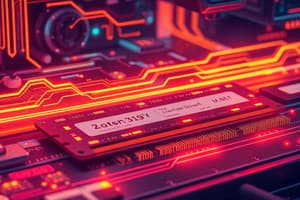Podcast
Questions and Answers
What is the basic structure of a computer?
What is the basic structure of a computer?
Central processing unit (CPU), motherboard, and power supply.
Which of the following are considered computer peripherals? (Select all that apply)
Which of the following are considered computer peripherals? (Select all that apply)
- Motherboard
- Mouse (correct)
- Monitor (correct)
- Keyboard (correct)
A device that sends information to the computer is called an ______.
A device that sends information to the computer is called an ______.
input device
An output device can send information back to the computer.
An output device can send information back to the computer.
What are the two basic types of computer memory?
What are the two basic types of computer memory?
Which of the following is an output device?
Which of the following is an output device?
What does RAM stand for?
What does RAM stand for?
Touchscreen monitors are considered strict output devices.
Touchscreen monitors are considered strict output devices.
Match the following computer peripherals with their categories:
Match the following computer peripherals with their categories:
What are computer peripherals?
What are computer peripherals?
Which of the following is NOT considered a computer peripheral?
Which of the following is NOT considered a computer peripheral?
Input devices are devices that ______ information to the computer.
Input devices are devices that ______ information to the computer.
What are the two basic types of computer memory?
What are the two basic types of computer memory?
An output device can both send and receive information from a computer.
An output device can both send and receive information from a computer.
Which of the following is an example of an input device?
Which of the following is an example of an input device?
Name two categories of computer peripherals.
Name two categories of computer peripherals.
Which type of memory is considered volatile?
Which type of memory is considered volatile?
Flashcards are hidden until you start studying
Study Notes
Computer Systems Overview
- Basic desktop computer consists of the computing unit, monitor, keyboard, and mouse.
- Peripherals connect to the computing unit but do not belong to its core architecture, which includes CPU, motherboard, and power supply.
- Core components are encased together, forming the main computing unit.
Computer Peripherals
- Definition: Any extra device that connects to the core computing unit to enhance functionality.
- Common peripherals include:
- Mouse
- Keyboard
- Monitor
- RAM
- DVD-ROM
- Microphone
- Webcam
- Printer
Categories of Computer Peripherals
-
Input Devices: Send information to the computer. Examples include:
- Mouse (controls cursor movement)
- Microphone (sends audio data)
-
Output Devices: Receive data from the computer without sending any back. Examples include:
- Speakers (produce sound)
- Monitors (display graphical information)
-
Input/Output Devices: Can both send and receive data. Touchscreen monitors are an example, as they interact with the computer.
Memory Types
- Essential for performing tasks; without memory, a computer cannot function.
- Primary Memory: Includes volatile RAM (Random Access Memory) and non-volatile ROM (Read-Only Memory).
- Secondary Memory: Non-volatile storage options such as hard drives and CDs, used for long-term data retention.
System Configuration
- Refers to the setup and arrangement of hardware components within a computer.
- BIOS Configuration: Basic Input/Output System settings that control booting and hardware configuration.
- PC Connection Interface: Determines ways peripherals are connected to the computer (e.g., USB, HDMI).
- RAID and GPU Basics:
- RAID: Redundant Array of Independent Disks, used for data redundancy and performance improvement.
- GPU: Graphics Processing Unit, essential for rendering images and video.
Summary
- Understanding the components, categories, and configurations of computer systems is crucial for optimizing performance and functionality.
Computer Systems Overview
- Basic desktop computer consists of the computing unit, monitor, keyboard, and mouse.
- Peripherals connect to the computing unit but do not belong to its core architecture, which includes CPU, motherboard, and power supply.
- Core components are encased together, forming the main computing unit.
Computer Peripherals
- Definition: Any extra device that connects to the core computing unit to enhance functionality.
- Common peripherals include:
- Mouse
- Keyboard
- Monitor
- RAM
- DVD-ROM
- Microphone
- Webcam
- Printer
Categories of Computer Peripherals
-
Input Devices: Send information to the computer. Examples include:
- Mouse (controls cursor movement)
- Microphone (sends audio data)
-
Output Devices: Receive data from the computer without sending any back. Examples include:
- Speakers (produce sound)
- Monitors (display graphical information)
-
Input/Output Devices: Can both send and receive data. Touchscreen monitors are an example, as they interact with the computer.
Memory Types
- Essential for performing tasks; without memory, a computer cannot function.
- Primary Memory: Includes volatile RAM (Random Access Memory) and non-volatile ROM (Read-Only Memory).
- Secondary Memory: Non-volatile storage options such as hard drives and CDs, used for long-term data retention.
System Configuration
- Refers to the setup and arrangement of hardware components within a computer.
- BIOS Configuration: Basic Input/Output System settings that control booting and hardware configuration.
- PC Connection Interface: Determines ways peripherals are connected to the computer (e.g., USB, HDMI).
- RAID and GPU Basics:
- RAID: Redundant Array of Independent Disks, used for data redundancy and performance improvement.
- GPU: Graphics Processing Unit, essential for rendering images and video.
Summary
- Understanding the components, categories, and configurations of computer systems is crucial for optimizing performance and functionality.
Studying That Suits You
Use AI to generate personalized quizzes and flashcards to suit your learning preferences.




